Are EVMs Hackable?
Context:
- The Supreme Court issued notice to the Election Commission of India(ECI) on a writ petition seeking a direction to mandatorily cross-verify the count in Electronic Voting Machines (EVMs) with votes verifiably recorded as cast by counting all Voter Verifiable Paper Audit Trail (VVPAT) slips.
- General elections will be held in India from 19 April 2024 to 1 June 2024 to elect the 543 members of the 18th Lok Sabha.
1.
What is an EVM?
- Electronic Voting Machine (EVM) was introduced in India in 1982 to allow the citizens to vote electronically and ease the job of the Election Commission of India in counting the votes.
- It was first used in the Paravur Assembly Constituency of Kerala in the year 1982.
- These EVMs have been designed by the Election Commission's Technical Expert Committee (TEC) in collaboration with two PSUs, Bharat Electronics Limited, Bangalore and Electronic Corporation of India Limited, Hyderabad.
- In 2003, all state elections and by-elections were held using EVMs.
Features of EVM:
- It comprises two units – control unit and balloting unit. They are connected by a 5-meter cable.
- The EVM runs on a 6-volt single alkaline battery fixed in the control unit.
- It can even be used in areas that have no electricity.
- The control unit is with the Election Commission selected polling officer.
- These EVMs have been designed by the Election Commission's Technical Expert Committee (TEC) in conjunction with two PSUs, Bharat Electronics Limited, Bangalore and Electronic Corporation of India Limited, Hyderabad.
- The M2 EVMs can cater to a maximum of 64 candidates including NOTA.
- There is provision for 16 candidates in a Balloting Unit. If the total number of candidates exceeds 16, more balloting units can be attached up to a maximum of 64 candidates by connecting 4 Balloting Units.
- The software part is discussed below:
What is ‘source code’?
- The source code is a set of instructions in human readable language written by programmers. It provides the foundation for software and programme for the EVM. The source code tells the machine how to function.
How it is designed?
- The crucial job of designing the source code and writing the software is carried out by a group of handpicked employees of the two public sector enterprises, Bharat Electronics Limited and Electronics Corporation of India Limited which also manufacture the EVMs. Both the PSUs are not under the control of the ECI. BEL is under the Ministry of Defence and ECIL reports to the Department of Atomic Energy. According to the "Status Paper on EVMs", The software of EVMs is developed in house by a selected group of engineers at BEL and ECIL independently from each other. This select software development group of few engineers design and develop the source code.
What is the role of Technical Evaluation Committees?
- The technical advice is given by the Technical Evaluation Committees (TECs). The Status Paper on EVMs does not spell out if the source code is shared with the TEC. Entire software is vetted by the TEC and sealed by them. Golden copy [the original copy, which is meaningless unless one knows the code for writing the copy remains under sealed condition only. This ensures that the software has really been written as per the requirements laid down for its intended use only.
Does the ECI have access to the software?
- The ECI does not even have access to the software that is loaded onto the EVMs. That right rests solely with the manufacturer and technical experts.
What is the chip or the microcontroller which is used in EVM?
- The microchip used in EVMs is a one-time programmable/ masked chip, which can neither be read nor overwritten. Hence, the program used in the EVMs cannot be reprogrammed in a particular manner. Blank chips are imported by BEL and ECIL. The source code is developed and programmed by them and coded on to the EVM chip – a special security microcontroller. Each chip or EVM would typically go through a minimum of 70-80 tests before deployment. In the new M3 EVM machine, the source code is also verified by the TEC (Technical Expert Committee) to ensure that the same source code binary is put in the micro controllers
Models of EVM:
- Presently, the M3 Model of ECI-EVM and VVPAT are used in elections.
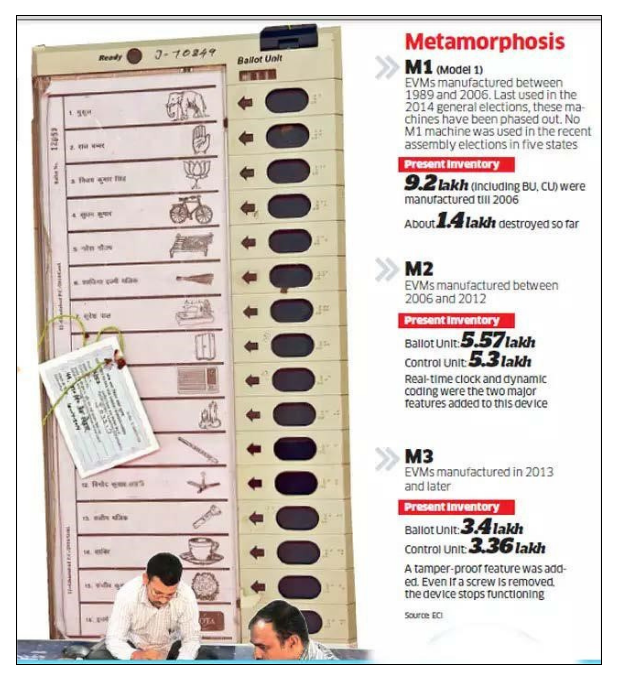
2.
Can EVMs be hacked?
- The EVM’s cannot be hacked due to the reasons given below:
| M1 (model one) of EVM machines |
|
|---|---|
| M2 model of EVMs |
|
| Tamper detection and self- diagnostics |
|
| Real time settings |
|
| ECI- EVMs are not computer controlled |
|
| ECI-EVMs do not have any frequency receiver or decoder for data |
|
| Very stringent security protocol |
|
| Most sophisticated technological features |
|
3.
What is the view of the Supreme Court on EVM?
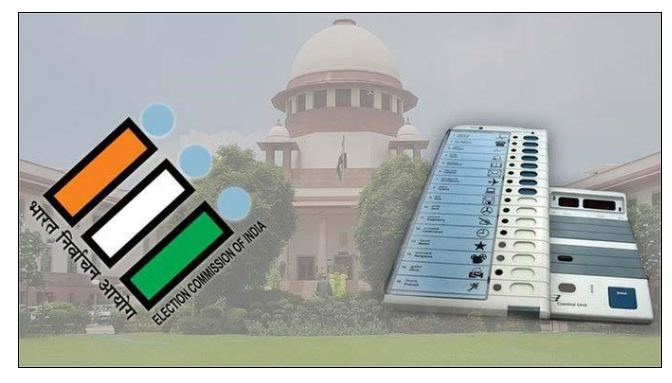
- The Supreme Court dismissed the petition alleging irregularities in the function of EVMs, citing, ‘Can't go by assumptions’.
- In a 2013 Subramanian Swamy V/s ECI case, the Supreme Court emphasized the necessity of implementing VVPAT in elections conducted through EVMs.
4.
What are the advantages and disadvantages of EVM?
| Advantages | Disadvantages |
|---|---|
|
Right to vote:
|
No certification:
Loss of data:
|
|
Difficult for the hackers to hack:
|
The highly humid area and those areas which receive frequent rainfall are not suitable for casting votes using electronic voting machines:
Most of the electronic voting machines used in the country were foreign manufactured:
|
|
Electronic voting machines are easier to carry and transport from one place to another without any hassle:
Time savers:
|
Fake votes:
|
5.
What are the electoral methods adopted in other countries?
Countries that use EVMs:
- Electronic Voting Machines are used in some of the world's largest democracies, including:
- Belgium
- Estonia
- Venezuela
- United Arab Emirates
- Jordan
- Maldives
- Namibia
- Egypt
- Bhutan
- Nepal
- India has given technical support related to the EVM to Jordan, Maldives, Namibia, Egypt, Bhutan, and Nepal. In these countries, Bhutan, Nepal, and Namibia are using Electronic Voting Machines made in India.
Countries which have banned EVM:
- Many countries of the world, including England, France, Germany, the Netherlands and the United States, have banned the use of EVMs due to political apprehensions.
| Countries | Method adopted for Electoral Process |
|---|---|
| USA |

|
| England |
 |
| Germany |
|
| Netherland |
|
| Italy |
|
| France |
|
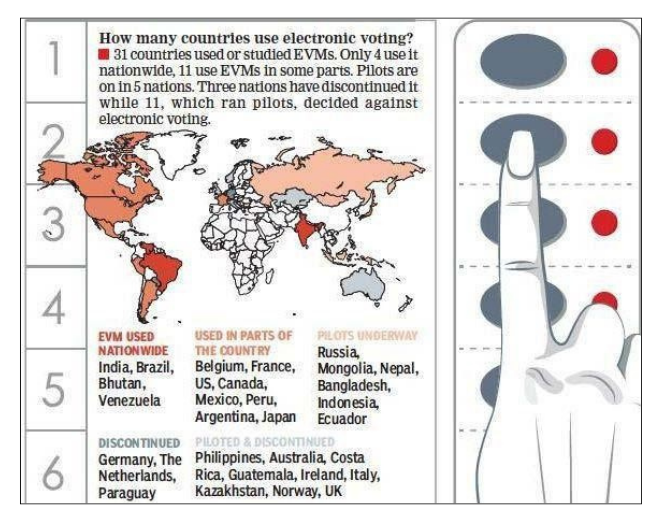
6.
What is VVPAT?
VVPAT was Introduced for the first time in India in the 2014 Lok Sabha elections, VVPAT or the Voter Verifiable Paper Audit Trail is basically a ballot-less vote verification system connected with the EVM.
- The SC in Dr. Subramanian Swamy v ECI (2013) held that VVPAT is an "indispensable requirement of free and fair elections".
- Initially introduced during the 2014 Lok Sabha elections in India, the Voter Verifiable Paper Audit Trail (VVPAT) is essentially a system for verifying votes without traditional paper ballots, directly linked with the Electronic Voting Machine (EVM).
- The VVPAT produces a paper slip visible to the voter, enabling them to confirm if their vote was accurately recorded on the EVM.
- This slip includes the name and symbol of the party the voter selected.
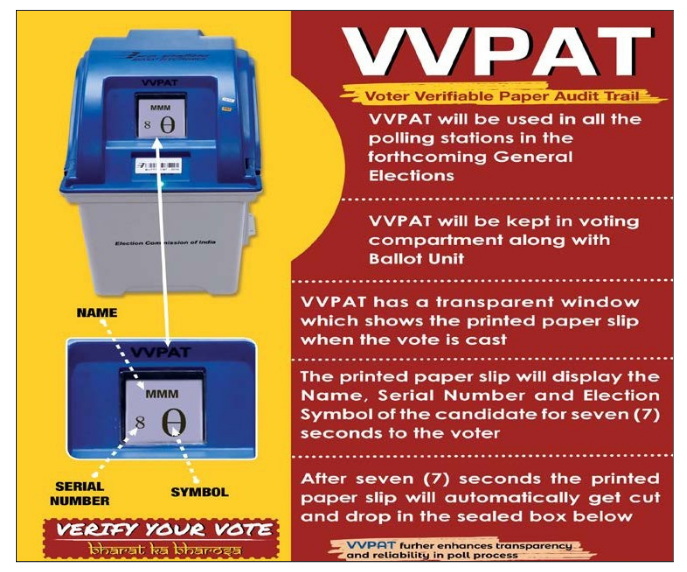
7.
What are the advantages & challenges of VVPAT?
| Advantages | Challenges |
|---|---|
Ensure transparency:
|
Technical Malfunctions:
|
 |
Light Sensitive:
High cost:
|
8.
What are few initiatives taken by ECI to ensure transparency in Elections?
1.
SVEEP (Systematic Voters’ Education and Electoral Participation)
- It was launched in 2009 as the flagship program of the ECI for voter education.
- SVEEP is the flagship program of the Election Commission of India for voter education, spreading voter awareness and promoting voter literacy in India.
- It is a multi-intervention programme that reaches out through different modes and media to educate citizens, electors, and voters about the electoral process in order to increase their awareness and promote their informed participation.
- SVEEP is designed according to the socio-economic, cultural, and demographic profile of the state as well as history of electoral participation in previous rounds of elections.
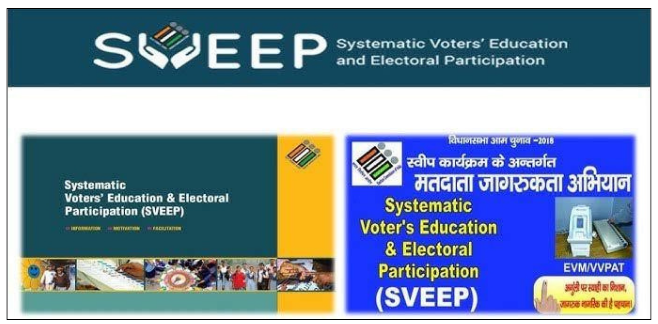
2.
C-Vigil app
- It is a mobile application developed by the Election Commission of India (ECI) to enable citizens to report violations of the Model Code of Conduct (MCC) during elections.
- It is a user-friendly and easy to operate application, which connects vigilant citizens with the District Control Room, Returning Officer and Flying Squads Teams.
- As soon as the complaint is sent on the cVigil app, the complainant will receive a unique ID through which the person will be able to track the complaint on their mobile.
- Users capture audios, photos or videos in real-time, and a “100-minute” countdown for time-bound response to complaints is ensured.
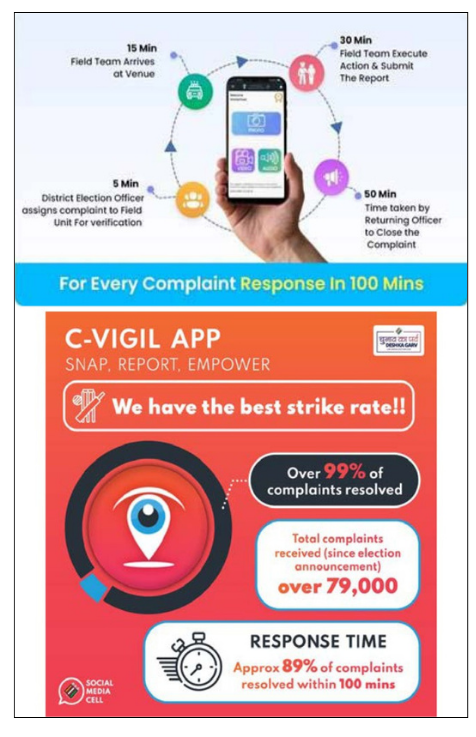
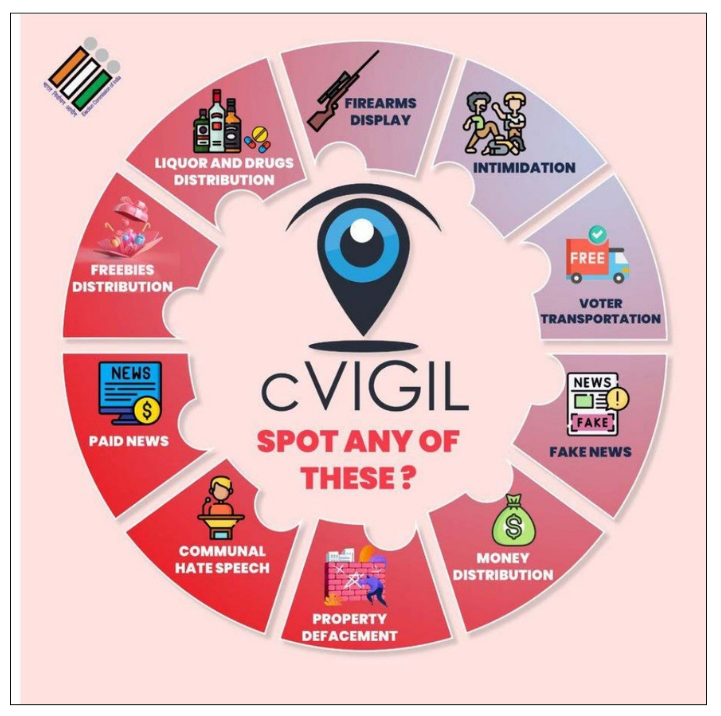
Why does the election schedule show 544 instead of 543 constituencies?
- When the Election Commission of India announced the dates for the General Election on March 16, it was noticed that the number of constituencies added up to 544 instead of tallying with the 543 Lok Sabha seats.
- This is because one Parliamentary constituency will have the distinction of going to the polls twice.
- Outer Manipur constituency alone will have elections on two days. This is done taking into consideration the recent ethnic violence in the north-eastern State.
9.
What is the relevance of the topic for UPSC CSE?
For Prelims: Electronic Voting Machines (EVMs), Postal Ballots, Election Commission (EC), Returning Officer (RO), Voter-Verifiable Paper Audit Trails (VVPATs), Chief Electoral Officers, Booth Level Officers (BLOs).
For Mains: The need for safety and security of Electronic Voting Machines and Postal Ballots in ensuring a robust, free and fair electoral process.
Some Previous Years Prelims Questions
Q1. Consider the following statements: (2017)
1. The Election Commission of India is a five-member body.
2. The Union Ministry of Home Affairs decides the election schedule for the conduct of both general elections and bye-elections.
3. Election Commission resolves the disputes relating to splits/mergers of recognised political parties.
Which of the statements given above is/are correct?
(a) 1 and 2 only
(b) 2 only
(c) 2 and 3 only
(d) 3 only
Some Previous Years Mains Questions
Q1. In the light of recent controversy regarding the use of Electronic Voting Machines (EVM), what are the challenges before the Election Commission of India to ensure the trustworthiness of elections in India? (2018)
Some Questions from this Year and Previous Years Interview Transcripts
Board Sanjay Verma sir:
-
Electoral reforms you think should be brought?
-
Online voting (he disagreed saying no trust on EVMs only)
Board Dinesh Dasa sir:
-
As you have worked on EVM so much controversy, why so?
Board Dinesh Dasa sir:
-
Role of technology in a democracy (talked about AI promoting inclusive growth and EVMs ensuring free and fair elections)
Board Dinesh Dasa sir:
-
Which word you will choose
-
From these two 1.EVM 2.Bull dozer
-
Why EVM?
Board RN Choubey sir:
-
Do you think EVMs can be hacked?
-
Your opinion on simultaneous elections?
-
Don’t you think it will subvert regional issues?
-
What is SVEEP?
-
Have you heard of NOTA? Do you think it is democratic?
Board RN Choubey sir:
-
EVM-VVPAT related allegations.
-
What would you do as an election officer if such allegations emerge during the poll process by the political party?
Board Dinesh Dasa Sir:
-
What issues are there in elections? Electoral process? Follow up questions on EVMs and criminalisation in politics?
Some Questions for QUIZ
Q1. Consider the following statements regarding Electronic Voting Machine(EVM)
1. It was first used in the Paravur Assembly Constituency of Kerala in the year 1982.
2. Since 1999 all state elections and by-elections were held using EVMs.
3. ECI can record a maximum of 2,000 votes.
How many of the above statements are incorrect? Select the correct answer using the code given below:
(a) Only one
(b) Only two
(c) All three
(d) None
Q2. Consider the following statements regarding VVPAT Machines
1. VVPAT Machines were first introduced in India in the 2014 Lok Sabha elections.
2. EVMs and VVPATs are separate entities and are not connected to any network.
3. VVPAT machines can be accessed only by the polling officers.
How many of the above statements are incorrect? Select the correct answer using the code given below:
(a) Only one
(b) Only two
(c) All three
(d) None
Some Questions for POLL
Q1. Can EVM be hacked ?
(a) YES
(b) NO
(c) Can’t say
Q2. Should paper ballots be used in place of EVM ?
(a) YES
(b) NO
(c) Can’t say
Q3. Can VVPAT ensure transparency in elections ?
(a) YES
(b) NO
(c) Can’t say